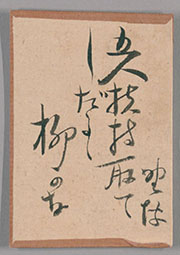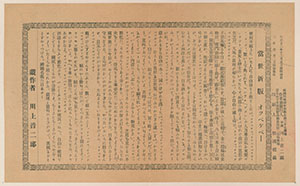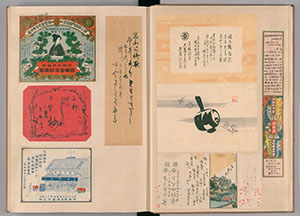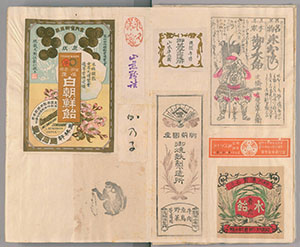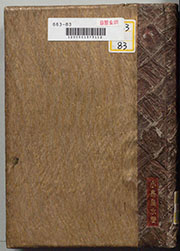70th Anniversary Commemorative Exhibit "A Treasure Box of Books - The 70-year History of the National Diet Library and Its Collections"
- A Treasure Box of Books
- Part 2 Diverse Collections
- Chapter 1 Beautiful Books and Rare Books
- Section 3 Various Rare Books
Part 2 Chapter 1 Section 3 Various Rare Books
The National Diet Library collection also holds a great number of curious books. This exhibition includes materials personally written by Masaoka Shiki, scrapbooks compiled by collectors, books with strange bindings, and pop-up books.
43 Zeppitsu sanku (Shiki's Last Three Haiku) by MASAOKA Shiki, 1902 [WB41-61]
These are the last three haiku poems left by poet Masaoka Shiki, who had a tremendous influence on modern Japanese literature, when he was dying. At around 11:00 am on September 18, 1902, Shiki had his sister Ritsu hold a drawing board with paper attached to it while he laid on his back to write the poems. Shiki died the next day at around 1:00 am on the 19th. He was only 34 years old. His creation of the poems, even as he struggled with his illness just before his death, truly shows his dedication as a haiku poet.
44 Shiki tesei haiku karuta by MASAOKA Shiki, around 1894-1895 [WB41-55]
This is a card game designed by Masaoka Shiki, based on the older game using Ogura Hyakunin Isshu (Hundred Poems by One Hundred Poets), and includes haiku by 100 poets including Matsuo Basho and his disciples. It is said that the cards were made by Shiki's mother and younger sister Ritsu by pasting on paper from medicine bags, with Shiki then adding the haiku sometime between 1894 and 1895. The game consists of a reader who reads a haiku while the players try to be the first to find and take the card on which that haiku is written. However, Shiki himself rarely played this game.
45 Harimazejo, Meiji Era [本別9-24]
Volume 5, Volume 9, Volume 4, Volume 1
This is a collection of hikifuda (handbills), bills, wrappers for sweets and chopsticks, ryaku-reki (abridged calendars), and other various printed materials. These pieces were formerly part of the collection of Negishi Takeka (the Kabutoyama Collection) who was a wealthy farmer in Kabutoyama, Yoshimi-mura, Osato-gun, Musashi no kuni (present day Saitama Prefecture) and also served as Saitama Prefectural Assembly chairman and as a member of the House of Peers.
- Volume 5
- Includes passenger tickets from various railways, entrance tickets to exhibitions, book discount tickets, and other materials from around 1897 to 1906.
Digital Collections
- Volume 9
- The displayed section is Kawakami Otojiro's Tosei shinpan oppekepe- (December 1889).
Digital Collections
- Volume 4
- Includes papers advertising toothpaste, dry goods stores, ryokan (Japanese-style inns), Kurume ikat cloth, dried plums, chicken egg vendors, and more.
Digital Collections
- Volume 1
- Includes papers advertising starch syrup, fried wheat gluten, ramune soda, white glutinous rice candy, and more.
Digital Collections
46 Shosai no gakujin by KOJIMA Usui, Shomotsu tenbosha, 1934 [663-83]
This work is a binding design book worked on by Shomotsu tenbosha, which was overseen by self-proclaimed "book nut" Saito Shozo. The cover is made of thinly cut tree bark and the mosaic patterns are actually made from the cases of bagworms. The cases of approximately 30 bagworms were used to make a single book. 980 copies were produced, causing Saito to remark in the Shintomicho tayori that he would "need to have funeral rites for the bagworms".
47 Saionji Kinmochi by KIMURA Ki, Shomotsu tenbosha, 1933 [643-5]
A bamboo bound book named after Saionji Kinmochi who was known for his love of bamboo and was called "Chikuken" ("chiku" meaning bamboo). The spine of the book is bound in three pieces of broken bamboo joined with string, and the cover is made of the sheaths of bamboo shoots with the spine title carved into the bamboo. The tied string is very strong, and the book was also carefully designed so as not to damage desks or tables. The bamboo sheaths were prepared so that they would not peel over a long period of time, which has also made them easy to clean, adding to the charm of the book.
48 Painted fans of Japan, C.E. Tuttle Co., 1962 [792.0952-T552p]
This is a book on Japanese folding fans which introduces 15 types of traditional Japanese folding fans used in Noh plays to non-Japanese. Opening the cover of the book, bordered with vividly colored brocade, one can enjoy depictions of a number of Japanese folding fans depicted against backgrounds representing the typical four seasons of Japan.
49 Little pets, E. Nister E.P. Dutton, 18?? [Y17-B5757]
The advancements in printing technology in 19th century England resulted in multicolored printed picture books being produced and a number of elaborate pop-up picture books also began to appear. In light of this, Ernest Nister, who worked on exhibition materials, began and was successful with a pop-up picture book specialized publisher. These books are characterized by the adorable illustrations of Victorian Era children and animals tailored to the contents of the stories.


